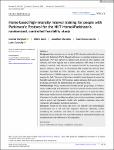Home‐based high‐intensity interval training for people with Parkinson's: Protocol for the HIIT‐Home4Parkinson's randomized, controlled feasibility study
| dc.contributor.author | Harpham, I | |
| dc.contributor.author | Gunn, H | |
| dc.contributor.author | Marsden, J | |
| dc.contributor.author | Bescos Garcia, R | |
| dc.contributor.author | Connolly, L | |
| dc.date.accessioned | 2024-01-08T09:34:04Z | |
| dc.date.available | 2024-01-08T09:34:04Z | |
| dc.date.issued | 2024-01 | |
| dc.identifier.issn | 2398-8835 | |
| dc.identifier.issn | 2398-8835 | |
| dc.identifier.other | ARTN e1800 | |
| dc.identifier.uri | https://pearl.plymouth.ac.uk/handle/10026.1/21881 | |
| dc.description.abstract |
Background High-intensity interval training (HIIT) is feasible and beneficial for some people with Parkinson's (PwP), although adherence to extended programs may be problematic. PwP face barriers to exercise such as lack of time, expense, and difficulty with travel logistics due to motor symptoms. HIIT based in the home setting if practical, could therefore be apposite for PwP by overcoming these barriers. However, until now, no home-based HIIT program for PwP has been developed. Cocreated by PwP, clinicians, and family members, the HIIT-Home4Parkinson's (HH4P) program is an innovative, 12-week home-based HIIT program for PwP. This protocol describes a feasibility study designed to assess the feasibility and safety of the HH4P program, explore outcomes that may be sensitive to change, and inform the implementation of a potential full trial. Methods/design Using a randomized controlled parallel group design, 24 independently mobile people with Parkinson's of mild to moderate disease severity will be randomized 1:1 to either the HH4P program plus usual care, or usual care alone. Both groups will be assessed at baseline, and upon the completion of the program. Outcomes will include feasibility and safety factors such as recruitment, completion, adverse events, and intervention fidelity with qualitative evaluation along with mechanistic, physiological, and clinical outcomes. Discussion Results of this study will inform the rationale and methodological considerations for a full trial with long-term follow-up. Ultimately, further establishing the practicality and utility of home-based HIIT could provide an important exercise option for PwP, potentially leading to extended participation and increased health and well-being for this population. | |
| dc.format.extent | e1800- | |
| dc.format.medium | Electronic-eCollection | |
| dc.language | en | |
| dc.publisher | Wiley Open Access | |
| dc.subject | exercise | |
| dc.subject | HIIT | |
| dc.subject | Parkinson's disease | |
| dc.subject | rehabilitation | |
| dc.subject | home-based | |
| dc.title | Home‐based high‐intensity interval training for people with Parkinson's: Protocol for the HIIT‐Home4Parkinson's randomized, controlled feasibility study | |
| dc.type | journal-article | |
| dc.type | Article | |
| plymouth.author-url | https://www.ncbi.nlm.nih.gov/pubmed/38192731 | |
| plymouth.issue | 1 | |
| plymouth.volume | 7 | |
| plymouth.publication-status | Published | |
| plymouth.journal | Health Science Reports | |
| dc.identifier.doi | 10.1002/hsr2.1800 | |
| plymouth.organisational-group | |Plymouth | |
| plymouth.organisational-group | |Plymouth|Faculty of Health | |
| plymouth.organisational-group | |Plymouth|Users by role | |
| plymouth.organisational-group | |Plymouth|Users by role|Academics | |
| plymouth.organisational-group | |Plymouth|Users by role|Post-Graduate Research Students | |
| dc.publisher.place | United States | |
| dcterms.dateAccepted | 2023-12-14 | |
| dc.date.updated | 2024-01-08T09:34:03Z | |
| dc.rights.embargodate | 2024-1-10 | |
| dc.identifier.eissn | 2398-8835 | |
| rioxxterms.versionofrecord | 10.1002/hsr2.1800 |


